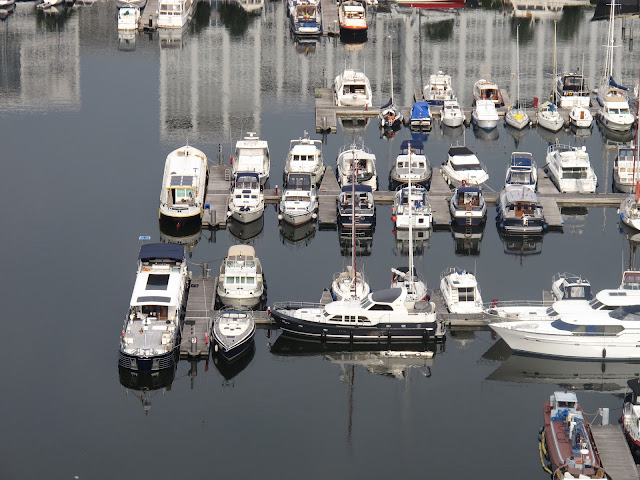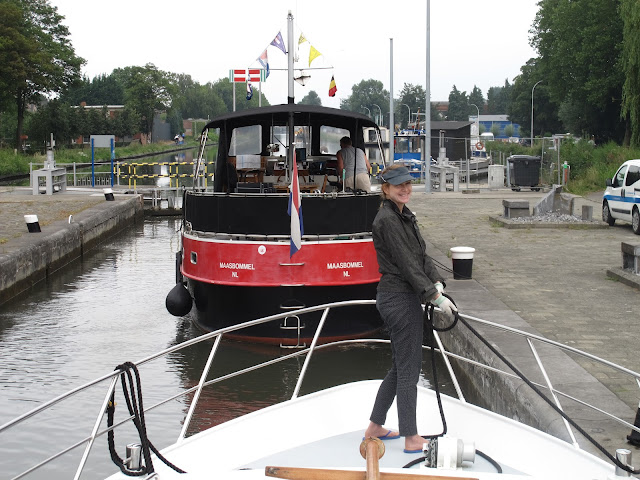Read about this trip from the start - here.
 |
| Marina in Antwerp |
Antwerp marina can accommodate some seriously big boats. Fancy shiny boats. The kind of boat an oligarch would have. We walked past them on the way to havenkantoor (harbour office). These are floating holiday homes. They have satellite TV, fresh flowers, pampered pets and designer interiors. Well heeled folk sit on their back deck sipping chilled prosecco or champagne and gaze down on the rest of us. We also walked past teeny tiny little yachts where no more than two people can squeeze in. All-weather gear is mandatory as they spend most of their time on deck. And they brush their teeth over the side of their boats - with a bottle of water. The variety in boats never ceases to amaze us. We love seeing old ex-working boats like tugs and trawlers lovingly restored by enthusiasts. Often a group of them will arrive together. And you get house-boats lurking on the waterways and in the marinas. There are people who live all year round on their boats. And sometimes take their homes on holiday. Handy that. We've met families who home-school their children and travel the world.
 |
| View of Antwerp from the Mas Museum |
Sundays not a lot happens. So we treated ourselves to a lie in. Even the supermarkets only open for a few hours. We took the day out to catch up on chores - laundry, boat washing, grocery shopping, e-mails, paying bills, etc. The weather was still hot. Europe had been having one of it's hottest summers with consistent highs and record breaking temperatures. We waited until early evening and then went to see the panoramic view of Antwerp from the top of the Mas Museum right next to the marina. It's free to go to the top which is the 10th floor. There is a fee to visit the rest of the museum.
Although boating is hardly arduous, it does requires concentration and planning. There's always a lock or a bridge or something that has to opened. You need to keep a watch for other waterway traffic - and humans. People do stand-up paddling, canoeing, swimming in the harbours and near the boats. And of course finding a space for the night can be a challenge. A day doing something different is a pleasant change. We took the next day out to travel by train to Ghent. My other half wanted a day there and for me to see Ghent as he's been there by ship a few times. We would have needed at least week to incorporate Ghent by boat. However it was a mere one hour train ride from Antwerp.
 |
| Belgium has nearly 400 different beers |
Our day got going fairly early and we hotfooted it up to Antwerp Cenraal train station. A fair walk from the marina. Antwerp Centraal station is a beautiful building. It has a wide domed ceiling with lots of curvy ornate bits. And gold coloured decorations. Very, very elaborate. There is a refurbished cafe where you can have a bite or a drink and soak up the opulence. We decided to do that when we got back. A few minutes later we were on our way to Ghent.
 |
| Antwerp Station |
Pity there wasn't much tourist info signage in Ghent. MapsMe to the rescue again. We sort of aimed for the centre of Ghent. Once in Ghent, the Tourist Information signs pointed in totally differing directions. Someone must have played a prank. Needless to say we got lost. Thankfully helpful locals guided us in the right direction and we found the Info Centre. Ghent is a cute olde world city with loads of cathedrals and historical buildings. Unfortunately we only had half a day to spare. How to choose what to do? My husband and I decided to do a canal boat tour and wander the streets. Have a meal somewhere. Have a Belgian beer somewhere else. And walk slowly back to the station. We found a fabulous veggie place called Greenways. We also tried a local sweet called a cuberdon or a "nose". It's a soft gooey cross between a wine gum and Turkish Delight. Made from Gum Arabic they're fine for vegans. Noses have a hint of violet but are fruit flavoured. One or two is enough as they are very, very sweet.
 |
| Ghent |
On the way back we stopped at the fancy cafe at Antwerp Centraal station to have a Belgian beer. I decided to try a Gauloise berry beer and my husband had a Gauloise dark beer. He loves these dark honey flavoured Trappist beers. I didn't think berries and beer would work. I was wrong. They are unbelievably nice. Refreshing. And pack an 8.2% alcohol content.
It was time to get going again. We were heading through the Kempen region toward Turnhout. As we left Antwerp harbour my husband called up the havenbestuurder (harbour manager) to Afmeld (de-register). New aerial, new cable, things should be fine. Unfortunately not. The mariphone was still working intermittently. Fortunately we had the Imray Inland Waterways of Belgium book. And fortunately they provide phone numbers and mobile numbers for bridges, locks, marinas and harbours. Although the book was printed in 2005, the numbers still work. My husband had also made sure his mobile phone was topped up - just in case. We used his phone a good few times on our trip.
 |
| Greenie on the Turnhout Kanal |
The other big thing we had to do was get a vignet. It's a licence disc you buy at one of the locks. You're supposed to stick it to the rear port side of your boat. The first lock keeper was on the ball and we didn't even have to ask for one. My other half keeps a file with all the boat details so it was all ready and waiting. You only need a vignet in Flanders, not in Wallonia. Begium is almost two countries. The Flemish speaking top half of Flanders and the French speaking bottom half of Wallonia. Brussels is an area in the middle that is both Flemish and French. It's almost a neat line dividing the country in half. Signs and notices are in Flemish up north and in French down south. Having said that, place names have a French AND a Flemish name. So if a French person talks about Liege (pronounced lee age) and a Flemish person is talking about Luik (pronounced lake) it's actually the same place. Belgians knows this. The rest of us don't. Mostly there is some semblance of similarity in the place names but not always. How about Lille and Rijsel? Or Haut Escaut and Bovenschelde?
The story continues - here.Labels: Antwerp, Ghent, Turnhout
